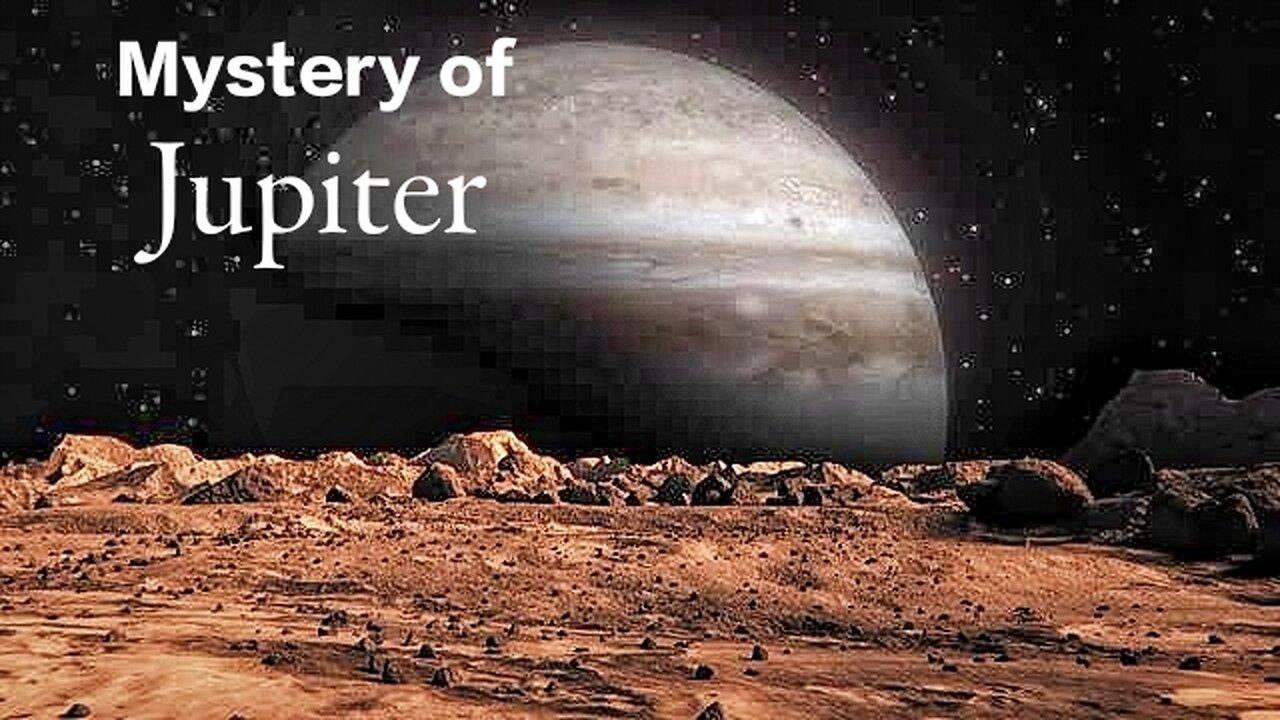Premium Only Content

Mysteries Jupiter | WhY is JUPITER ACTING WEIRD?😦
Scientists Are Worried! Something Wrong Is Happening on Jupiter....
The physics of Jupiter are hard for even space scientists to imagine. Jupiter is made up of 90 percent hydrogen, which exists in the outer layers as gas (just like on Earth). Deeper inside the planet, however, the hydrogen is under so much pressure that the electrons are squeezed out, creating a fluid that conducts electricity like a metal, according to a 2011 NASA feature story.
This process creates a huge magnetic field within the planet, which is also strengthened by Jupiter's rapid rotation. Auroras shine brighter on Jupiter than anywhere else in the solar system. At the core of Jupiter, however, the composition is anyone's guess. No one is sure how far the liquid hydrogen layer penetrates and if the core has heavier elements inside.
Juno aims to figure out more about Jupiter's insides by examining the planet's atmosphere, gravity and magnetic field. Its work suggests that Jupiter may have a "fuzzy" core, "much larger than anyone had anticipated," Bolden said in a 2018 press conference.
ance
3. Core
4. Storm depth
5. Interior rotation
6. Magnetic field
Aurora
8. Life
9. Jupiter's effect on moons
10. Gas giant evolution
References
All hail the king of planets and its many mysteries.
Advertisement
Jupiter is the most massive planet in our solar system and it's easy enough to spot with the naked eye. While big telescopes can get a good look at the gas giant planet, bringing a spacecraft within reach provides a close-up view.
Numerous spacecraft orbited or flew by Jupiter in the past five decades. The first were Pioneer 10 and Pioneer 11 in 1972 and 1973, respectively, followed by twin flybys by Voyager 1 and Voyager 2 in 1977. Other prominent missions include the Galileo spacecraft (orbiting between 1995 and 2003) and most recently, NASA's Juno (2011-2022).
Sponsored Links
These Investment Property USA May Be Easier to Get Than People Think
Property investment USA | Search Ads
Based on a past interview with Juno principal investigator Scott Bolton and information from the European Space Agency (ESA), here are 10 mysteries we have about Jupiter that may be solved with more study. Luckily, two more missions will head out that way very soon: NASA's Europa Clipper that launches no earlier than 2024, and ESA's Jupiter Icy Moons Explorer (JUICE) scheduled to lift off in 2023 or so.
In Photos: Juno's amazing views of Jupiter
Advertisement
HOW DID JUPITER GET ENRICHED IN HEAVY ELEMENTS, COMPARED WITH THE SUN?
several hurricane shaped storms in the upper atmosphere of jupiter
Powerful storms around the north pole of Jupiter captured by NASA's Juno mission. (Image credit: NASA/JPL-Caltech/SwRI/MSSS Image processing by Brian Swift )
Jupiter is 317 times more massive than the Earth, making it a real heavyweight in the solar system. It is believed that the planets in the solar system formed from the same hydrogen-helium cloud from which the sun was created. But here's the catch: The Galileo probe, which looked at Jupiter in the 1990s and 2000s, found a different abundance of heavy elements in Jupiter than in the sun.
One theory (proposed at the time by Galileo scientists) is that Jupiter's heavy elements come from the numerous comets, asteroids and other small bodies that it has pulled in and "consumed" when they get too close. But scientists aren't quite sure. Alternatively, a newer study based on Juno data suggests Jupiter may have formed four times farther away from the sun than the gas giant's orbit, which may explain the strange abundance.
Related: This jaw-dropping Jupiter photo is a photographer's sharpest ever and made of 600,000 images
2. WHAT IS THE GLOBAL ABUNDANCE OF WATER IN JUPITER?
jupiter with a set of pixellated data showing water abundance on top
The distribution of water in Jupiter's stratosphere as seen by the Herschel Space Telescope. (Image credit: Water map: ESA/Herschel/T. Cavalié et al.; Jupiter image: NASA/ESA/Reta Beebe (New Mexico State University))
Water is key to understanding how Jupiter was formed. Water ice hitchhiking on early comets or asteroids brought heavier elements to Jupiter besides the original hydrogen and helium floating around in the solar system, according to the Southwest Research Institute
A surprising recent finding is just how persistent water can be after a comet crashes into Jupiter. A famous comet called Shoemaker-Levy 9 broke up into pieces before peppering the planet in July 1994. About 20 years later, the Herschel Space Observatory detected an abundance of water in Jupiter's stratosphere that came from Shoemaker-Levy 9 (which was clear because most of the water vapor was around the impact sites).
At least one Juno study found a surprising amount of water in Jupiter compared to what models suggested. Water may make up about 0.25% of the atmospheric molecules over Jupiter's equator, much higher than previous measurements from Galileo. Figuring out why the two spacecraft have different estimates is key to better determine the recipe for planet formation, NASA officials said at the time.
In photos: 10 extraordinary ocean worlds in our solar system
3. WHAT IS THE NATURE OF JUPITER'S CORE?
jupiter half in shadow, half of planet visible
This view of Jupiter’s south pole was created using data from NASA’s Juno spacecraft. (Image credit: NASA/JPL-Caltech/SwRI/MSSS/Gabriel Fiset)
The physics of Jupiter are hard for even space scientists to imagine. Jupiter is made up of 90 percent hydrogen, which exists in the outer layers as gas (just like on Earth). Deeper inside the planet, however, the hydrogen is under so much pressure that the electrons are squeezed out, creating a fluid that conducts electricity like a metal, according to a 2011 NASA feature story.
This process creates a huge magnetic field within the planet, which is also strengthened by Jupiter's rapid rotation. Auroras shine brighter on Jupiter than anywhere else in the solar system. At the core of Jupiter, however, the composition is anyone's guess. No one is sure how far the liquid hydrogen layer penetrates and if the core has heavier elements inside.
Juno aims to figure out more about Jupiter's insides by examining the planet's atmosphere, gravity and magnetic field. Its work suggests that Jupiter may have a "fuzzy" core, "much larger than anyone had anticipated," Bolden said in a 2018 press conference.
Related: What is Jupiter made of?
4. HOW DEEP DO THE ZONES, BELTS AND STORM FEATURES, SUCH AS THE RED SPOT, GO?
a close-up of the great red spot inside a chart showing latitude and longitude
A flake of red peels away from Jupiter’s Great Red Spot during an encounter with a smaller anticyclone, as seen by the Juno spacecraft’s high resolution JunoCam on 12 February 2019. Although the collisions appear violent, planetary scientists believe they are mostly surface effects. (Image credit: AGU/Journal of Geophysical Research: Planets)
Images of Jupiter show thick stripes and swirling storms, but most of these pictures capture only the tops of the clouds that cover the giant planet. It's unclear what the weather is like deeper down, inside Jupiter, and whether the features that can be seen on the surface are present below. Juno observations suggest that is indeed the case, and that the bands, storms and other surface weather we can see may persist for thousands of miles (or kilometers) into the massive gas giant planet, and is going deeper than what the spacecraft is capable of seeing.
Understanding the long-term weather on Jupiter will also help scientists solve mysteries such as why its Great Red Spot is shrinking. This storm feature has been known to astronomers ever since telescopes were first available in the early 1600s. Once estimated as large enough to fit three Earths across its width, the storm is now no bigger than Earth's diameter.
When you look at the exterior of Jupiter, you can see that the zones and bands don't move in concert with each other. There are changes in their rotation and sizes from night to night, changes that are even apparent in amateur telescopes.
Deeper down in Jupiter's atmosphere, what is happening is even less understood. To date, planetary probes have mostly been looking at the surface of the giant planet. Juno's work suggests that the interior may in fact move as a "nearly rigid body", according to NASA, which is opposite to how one would expect gases to behave.
Figuring out the transition between the surface, fluid weather into this zone will be a task for Juno in its final years, as the interior of Jupiter may be indicative of the structure at Saturn and other gas giants.
-
 LIVE
LIVE
Vigilant News Network
13 hours agoFBI EXPOSED: New Development Rocks J6 Pipe Bomb Scandal | The Daily Dose
3,343 watching -
 1:27:24
1:27:24
Game On!
9 hours ago $2.72 earnedEagles DOMINATE Washington on TNF thanks to Saquon Barkley!
12.2K1 -
 17:10
17:10
Film Threat
23 hours agoDUNE: PROPHECY EARLY REVIEW | Film Threat Reviews
83.5K9 -
 51:29
51:29
Uncommon Sense In Current Times
11 hours ago $19.51 earned"Why This Election Was For Protecting Christian Freedom"
47.6K7 -
 10:46
10:46
Degenerate Jay
16 hours ago $12.08 earnedThe Rejected Superman Ending Of Smallville Would Have Changed Everything
37.4K8 -
 19:01
19:01
Jamie Kennedy
15 hours agoWe're in a World of Dummies! | From Ep. 176 Hate to Break It To Ya w/ Jamie Kennedy
38.8K5 -
 3:54
3:54
BIG NEM
23 hours agoWelcome to #NEMSWORLD UNCUT. The World's First Uncensored Sketch Comedy Podcast.
27.1K4 -
 3:09:28
3:09:28
Price of Reason
17 hours agoElon Musk TARGETED By Hollywood & MSM! Yellowstone DISAPPOINTS! Dragon Age Veilgard DISASTER!
117K24 -
 5:03:12
5:03:12
Akademiks
13 hours agoLil Durk Pleads NOT GUILTY and Hires NBA Youngboy Lawyer To Represent him! Lil Baby tryna comeback?
146K14 -
 3:27:19
3:27:19
SNEAKO
14 hours agoSNEAKO X JACE!
109K12